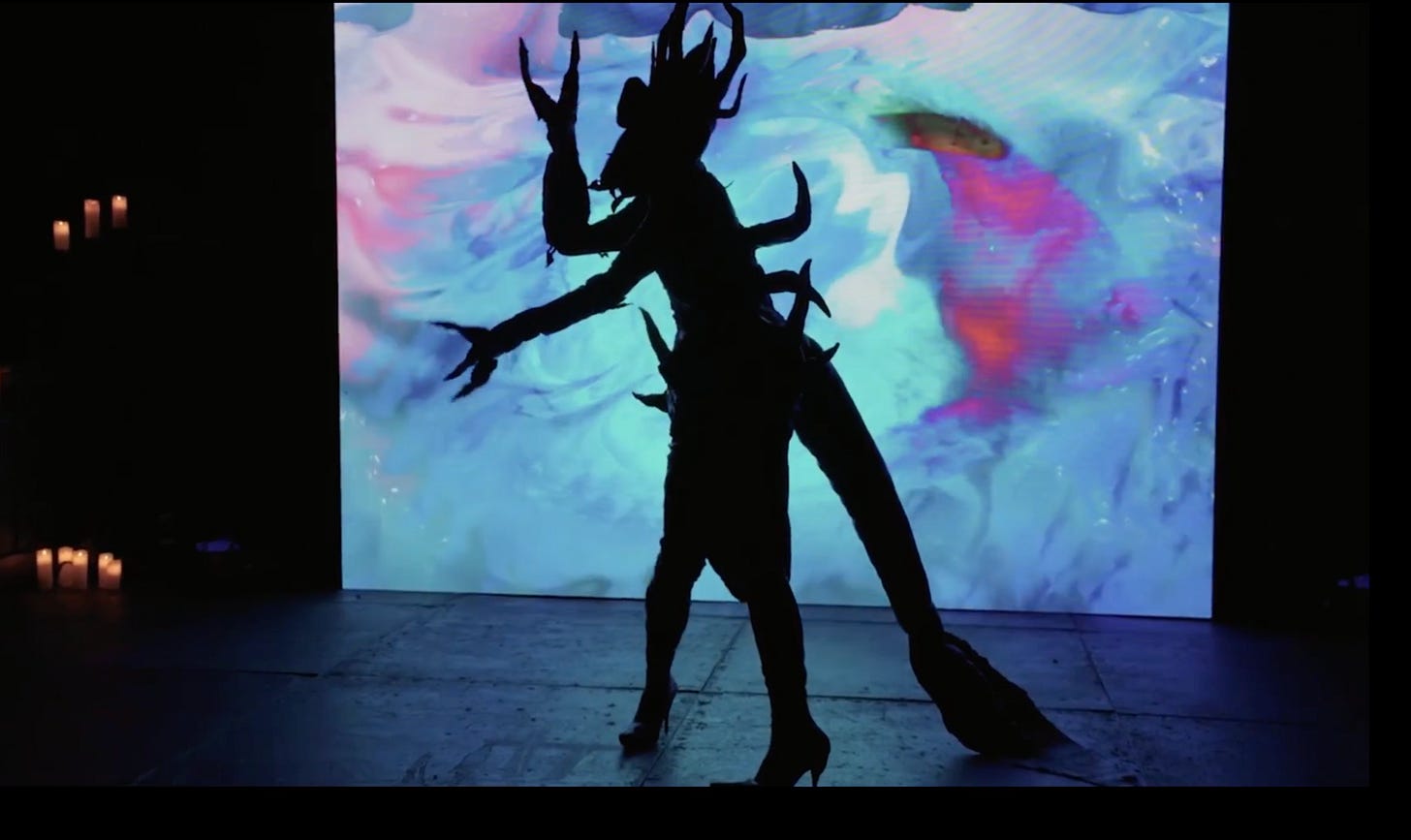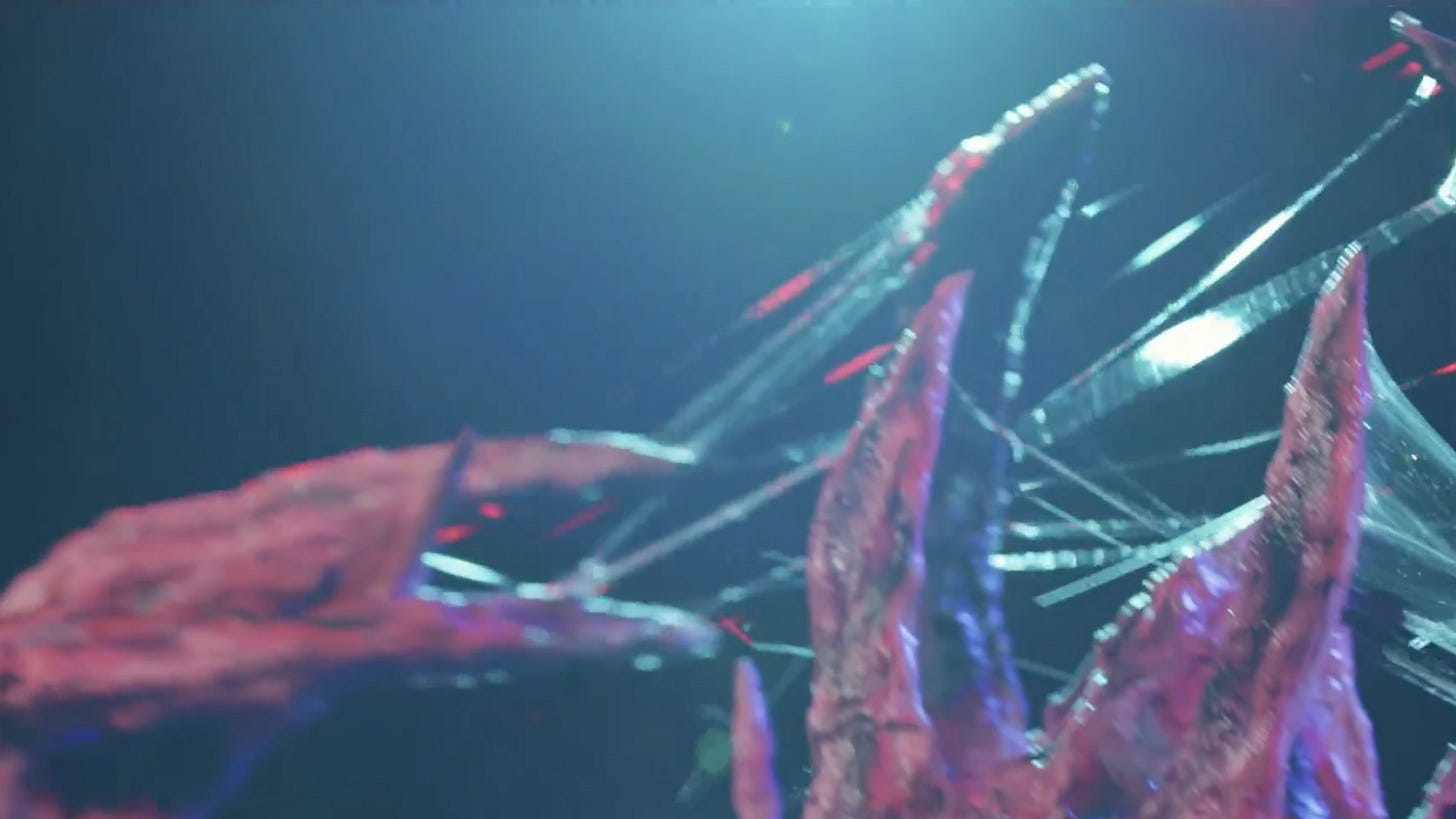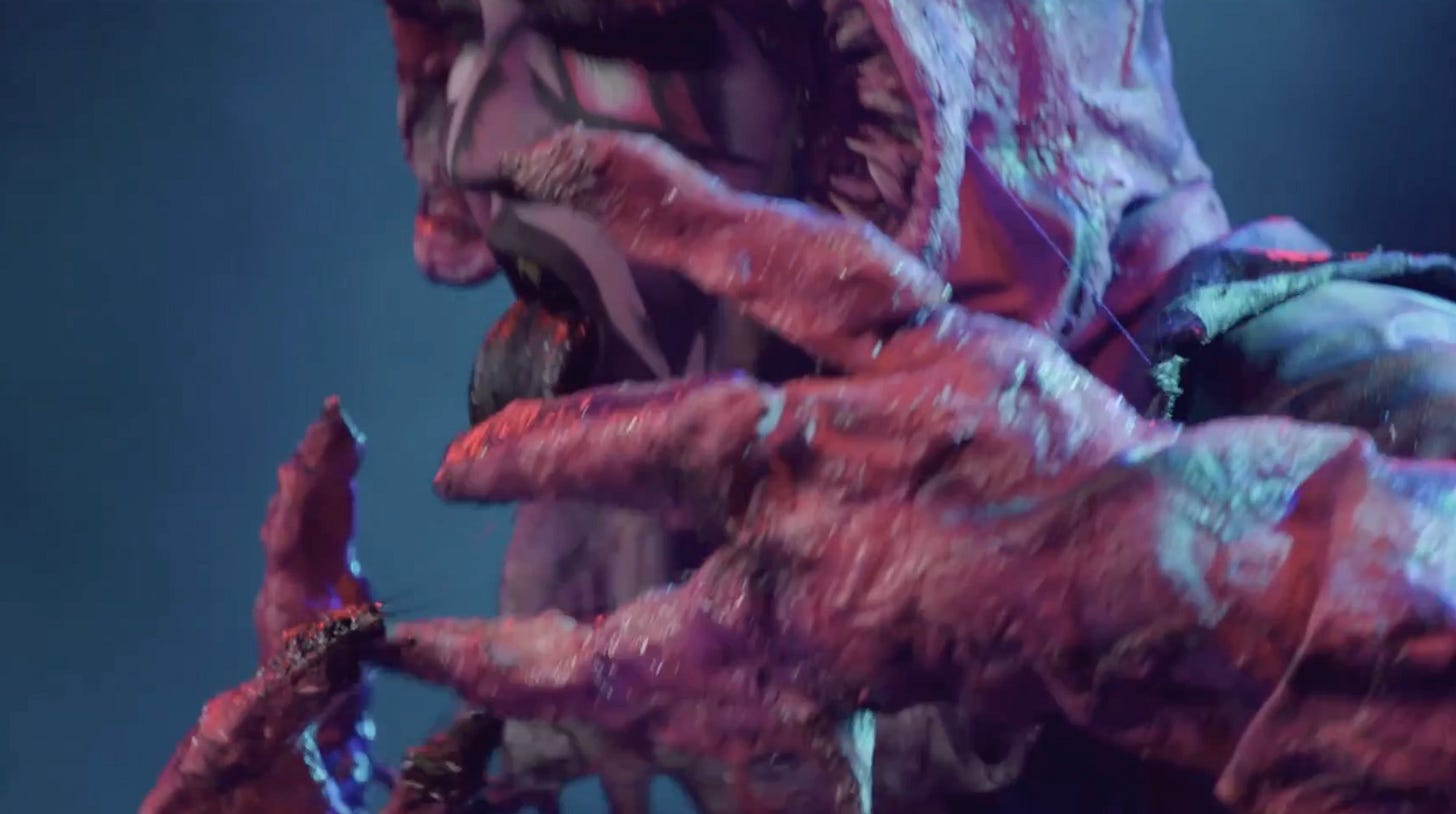monstrous drag
transgressing the ornamental object/abject of desire on the boulet brothers' "dragula"

The Boulet Brothers’ Dragula1 is a reality competition series that features drag artists from around the world, whose alternative approaches to drag embrace the show’s visions of horror, filth, glamour, and drag. After four seasons, the Boulet Brothers created a spin-off competition, The Boulet Brothers’ Dragula: Titans, where ten contestants from the show’s previous seasons return in the pursuit of redemption, with the hope of becoming “The World’s Next Drag Supermonster”.
Having previously lost Season Four, HoSo Terra Toma returns to the competition to surpass her status as runner-up. Each of her performances–her approaches to costuming, makeup, and acting–are deeply saturated with her subjectivity as a south Korean transfemme individual, which are vastly re/de-contexualized as she relocates to the u.s. stage. Rendered a temporary diasporic figure, HoSo’s drag enactments of the monster interrogate cisheteropatriarchal, settler-colonial, imperialist visions of the monster which are foundational to the core of this competition, given its conception through a western scope. Despite the Boulet Brothers’ rejection of normative drag’s exclusivity, this competition replicates normative ideas of the monster: a figure both cast from and existing beyond the normative human.
Episode Seven, titled “Sea Monsters of the Depths,” reveals perpetual processes of racialized queer failure and failing within hegemonic structures, with additional failure facilitated by the reproduction of normative western aesthetics and cultural ideologies in queer and trans spaces. In tracing HoSo’s failure to enact monstrous drag, I explore nonhuman drag, disidentifications, and the destabilization of ornamental objecthood and abjecthood in the production of diasporic queer and trans imaginaries.

HoSo’s failed hagfish drag interrupts Dragula’s reestablishment of normative marginality in the already minoritarian alternative drag scene, as she enacts imaginings of a monster grounded in cultural, political, and ancestral histories. The hagfish secretes slime from its porous, hole-scattered flesh. Its jawless frame enables its mouth to expand, revealing rows of jagged teeth to consume carcasses left on the ocean floor, detected through its single nostril which senses decay. Despite its horrific characteristics, the hagfish’s nonexistence within the western cultural vision of the monster renders HoSo’s drag performance illegible. The entire cast misses her obscene mode of being as they originate from the united states, never having encountered the creature. She is questioned to be a “pink-skinned alien, an insect, and a shrimp”.
Contextualized through Dana Luciano, Mel Y. Chen, and Gloria Anzaldua’s writings, this “locates [HoSo’s] work on a terrain of contestation, [as the Boulet Brothers, judges, and cast members] must peel away racialized and gendered associations… that [her] bodily appearance triggers in Eurocentric ways of seeing”.2 HoSo’s identification with the hagfish contextualizes broader constructions of the human and nonhuman in the u.s., as her critiques are steeped with racialized, gendered sentiments pointing toward the animalized, effeminate, Asian other. Specifically reduced to an alien and a shrimp, commentary on HoSo’s monstrous drag exposes the historical and contemporaneous repudiation of transfeminine Asianness from conceptions of humanness granted through whiteness, cisheteronormativity, and citizenship. It is this “material attachment and nonhuman turn”3 to the hagfish that illuminates the violent residue of queer and trans racialization within Dragula.
HoSo’s corporeal embodiment of a creature located outside the colonial and imperial imagining of that which is monstrous, underscores the maintenance of dominant ideological narratives and aesthetic formations of the monster embedded in the core of the competition, and the queer and trans community at large. HoSo's migration from south Korea renders her an outsider of citizen subjecthood. Through the framework of Luciano and Chen’s work, we see how her diasporic positioning brings forth a spatial-temporal reckoning that contextualizes ongoing histories of “occupation, settlement, displacement, and colonization”4 forged by the u.s. and cooperatively upheld by the south Korean cisheteropatriarchal, neoliberal, capitalist regime. These regimes are further linked through their negation of queerness and transness. HoSo fails to integrate into three spheres of normativity: in south Korea as a gender nonconforming citizen, the u.s. as a transfemme diasporic Korean non-citizen, and Dragula as an inadequate, unidentifiable, monstrous other.

HoSo’s persistence in the face of monstrous injury and gendered racialization in Dragula reflects a form of negotiation necessary for survival across the various majoritarian spaces. This drag performance reveals the transformative potentiality of disidentificatory practices in the imagining of alternative worlds for diasporic queer and trans people. Through José Esteban Muñoz’s theory of disidentifications, HoSo’s hagfish drag offers an anticolonial, anti-imperialist, ancestrally grounded form of embodiment that facilitates the imagining of material, aesthetic, ideological worlds beyond our own.
These hagfish imaginings, these riotous glimpses "into other worlds are more than simply views or perspectives; they are oppositional ideologies that function as critiques of oppressive regimes of “truth” that subjugate minoritarian people”.5 While Dragula is propelled by its desire to embrace subcultural and countercultural drag, the Boulet Brothers’ subjectivity as white, citizen subjects undermines their invitation for contestants to create “a new look inspired by the horrors of the deep; [to mutate into] something so sinister it can’t even be described”. They manage to trample on their own manifesto for the outrageous, as they overlook the integral role of the u.s. as the primary supplier of hagfish for korean consumption and delight.
Despite the permeation of Korean media into the mainstream, the culture remains a surfaced-spectacle in the dominant imagination. Yet, the u.s. itself is sutured into the fabric of Korean consciousness through decades of occupation, settlement, displacement, and colonization, all under the guise of democratization, modernization, and protection against communism. Co-facilitated by south Korea’s dominant forces, the u.s. regime actively preserves the severing of the peninsula and its people, to secure its unyielding lust for more. Its desire for material, geopolitical, and ideological domination is exposed through the dragging of the hagfish, as HoSo's transmaterial embodiment of this creature confronts viewers with the very material relations binding these majoritarian regimes together.
This disidentificatory drag performance as an act of labor drags this dominant agenda, and materializes the subjugation, exploitation, and abuse of diasporic peoples. In doing so, she illuminates the erasure of transness, gender nonconformity, and queerness from normative conceptions of humanness across the diaspora in both the u.s. and south Korea. HoSo harnesses hagfish drag as a political, cultural, and social tool–a deconstructive, generative mode of counter-identification, grief, longing, and desire–to reimagine diasporic transness and queerness through this filthy, ancestrally-commemorative mode of being.

HoSo’s hagfish drag locates the points of convergence between gendered, sexualized material, and colonial modes of desire and disgust; this performance can be investigated through the destabilization of the ornamental figure, by considering the objectification and abjectification of the diasporic Korean trans and queer figure. Anne Anlin Cheng’s theory ornamentalism describes the making of Asiatic femininity through synthetic, aesthetic, manufactured objecthood in the culmination of the yellow woman.
Cheng’s theorization of the yellow woman excludes the implications of transness, queerness, and gender nonconformity, overlooking the crucial ways in which creaturely, object-attachments sustain otherwise precarious existences; of connecting to creatures existing wholly as they are, free from the confines of oppressive systems. Systems which strip beings of the oddities that culminate in a sensationally unique form. She states how “the yellow woman denotes… an insistently aesthetic presence that is prized and despoiled… [whereby] aesthetics and violence both enact experiences that distort the borders between subject and object, consumer and consumed”.6
By dragging the hagfish, HoSo exposes its cultural uses as a sexualized object, consumed by south Korean men as an aphrodisiac. She links this creature to normative and centralized understandings of desire, sexuality, and pleasure, destabilizing the ornamentalist aesthetics of the yellow woman by not only indulging in, but finding joy and respite in undesirable aesthetics, gestures, and embodiments. The negation of trans, queer, and gender nonconforming figures in the discourse of gendered subjugation, domination, and violence across the diaspora is an invisibilizing tactic that perpetuates the ongoing efforts to erase transness from the public. It works in favor of dominant agendas denouncing transess as a shameful blemish on the flesh of society.
This embodiment of a racialized, repugnant, abject thing conveys the dehumanization of the yellowed figure. HoSo transgresses demeaning assertions of the nonhuman, the yellowed, and the transgender, by harnessing the very materials and ideologies weaponized in the attempted destruction of deviant beings, in the imagining of a life free of hopelessness, loneliness, loss, and failure.

It is within this failure that ongoing histories of domination may be transgressed through grotesque, nonhuman drag. HoSo embarks on an unbounded, imaginative mode of being that emboldens cultural, ancestral, and collective difference in the production of rambunctiously queer and effervescently trans worlds. Her subversion of desire, sexuality, and racialized gender urge us to imagine a world beyond this arduous here and now. She boldly harnesses diasporic transness and queerness as a form of desire that emphatically necessitates queer idealism as a tool of survival.
This performance exists as an elsewhere–it is a moment situated outside of our present day and time–so vile, perverse, monstrous, and free, emboldening a collective refusal to succumb to acceptable, digestible categorizations of being. It brings to life an unruly aliveness that gnashes the colonial imagination with its jagged, slime-coated teeth. The residue of alienation and the noxious fumes of whiteness, sexual violence, and transphobic brutality dissipate, leaving us with a longing for a life imbued with tenacity.
Drag compels us to trudge through the degenerative present, which not only insists on survival, but gestures toward a boundlessness beyond the denigration and dehumanization of diasporic queer and trans human beings.7
This show absolutely changed my life and I have to thank one of my best friends for introducing me to it—thank you Kevin, ily, you are the best. This summer, Kevin and I were sitting on the floor of his apartment. While he was giving me a tattoo—I sat there with my arm propped up on the stool he found on the side of the road—I remained in awe of, in love with, dAZZLED by the performers. I basked in their bravery, their boldness, their unbounded expression and play. I started writing about HoSo for fun before school started, until I saw a call for conference papers on losers (me asf) and kNEW there was something here. Queerness, transness more specifically, is so mired in loss and losing and failure in public thought. But this loss! It is profound and generative because it demands and urges and beckons! for more. More what? Idk like more. Not a specific thing, just that extra flavour, that care, that ripe, abundant, glowing love for life. Something like that. Ok but anyways this is what this writing is. I started school and haven’t had time to write said writings but alas! I have been writing and writing and my brain can no longer. It’s run out of thoughts! That should be vastly apparent in this footnote. SO with that being said: I watched dragula, I wrote a little somethin somethin about HoSo that happened to magically follow the thread of ancestral transness I’ve been pondering for the last year (lifetime), I wrote a paper, I presented said paper at a First Forum (the USC Cinema and Media Studies Graduate Student Conference hosted and organized and brought to life by my most wonderful friend Yousef (thank u for this opportunity i love u)), and yeur! ok bye i love u thank u for reading if u made it this far <3
Dana Luciano and Mel Y. Chen, Has the Queer Ever Been Human? (Durham: Duke University Press, 2015), p. 183.
Ibid., p. 185.
Ibid.
José Esteban Muñoz, Disidentifications: Queers Of Color And The Performance Of Politics (Minneapolis: University of Minnesota Press, 1999), p. 321.
Anne Anlin Cheng, Ornamentalism (Oxford: Oxford University Press, 2019).
PLS this is the first draft. Don’t fret with grammatics/dramatics! We know my writing verges on theatrical but bare/bear? with me. Stay tuned for this paper’s future iteration hhehehee




